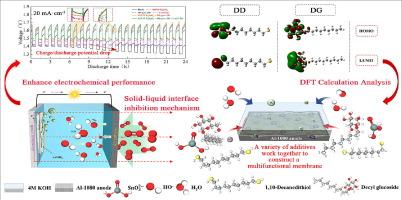Evolution of the solid-liquid interface using a novel hybrid corrosion inhibitor to improve Al-air battery performance
IF 14.9
1区 化学
Q1 Energy
引用次数: 0
Abstract
Aluminum-air batteries (AABs) are considered the most promising candidates in advanced clean energy conversion and storage due to their low density, high specific energy, and abundant aluminum resources; however, the development of AABs is constrained by inevitable parasitic side reactions and anodic surface passivation film formation. The present work introduced an innovative hybrid corrosion inhibitor consisting of potassium stannate, decyl glucoside, and 1, 10-decanedithiol to regulate solid-liquid interface reactions in alkaline AABs. The findings indicated that the optimal hybrid corrosion inhibitor could reduce the hydrogen evolution rate from 0.2095 to 0.0406 mL cm−2 min−1, achieving an inhibition efficiency of 80.62%. The surface analysis discussed in detail the evolution process of the solid-liquid interface after the introduction of the hybrid corrosion inhibitor into the battery. Experiments and theoretical calculations revealed that decyl glucoside enhanced the adsorption and coverage efficiency of the hybrid corrosion inhibitor through the “micelle solubilization” effect and optimized the structure and properties of the solid-liquid interface. This study also contributed valuable insights into the corrosion inhibition mechanism at the solid-liquid interface of alkaline AABs.

一种新型混合缓蚀剂改善铝空气电池性能的固液界面演变
铝空气电池(AABs)因其低密度、高比能和丰富的铝资源而被认为是先进清洁能源转换和存储最有前途的候选者;然而,自身抗体的发展受到不可避免的寄生副反应和阳极表面钝化膜形成的限制。本文介绍了一种由锡酸钾、癸基葡萄糖苷和1,10 -癸二硫醇组成的新型杂化缓蚀剂,用于调节碱性单抗的固液界面反应。结果表明,最佳杂化缓蚀剂可将析氢速率从0.2095 mL cm−2 min−1降低至0.0406 mL cm−2 min−1,缓蚀效率为80.62%。表面分析详细讨论了混合缓蚀剂引入电池后固液界面的演变过程。实验和理论计算表明,癸基葡萄糖苷通过“胶束增溶”效应提高了杂化缓蚀剂的吸附和覆盖效率,优化了固液界面的结构和性能。该研究还对碱性单抗在固液界面的缓蚀机理提供了有价值的见解。
本文章由计算机程序翻译,如有差异,请以英文原文为准。
求助全文
约1分钟内获得全文
求助全文
来源期刊

Journal of Energy Chemistry
CHEMISTRY, APPLIED-CHEMISTRY, PHYSICAL
CiteScore
19.10
自引率
8.40%
发文量
3631
审稿时长
15 days
期刊介绍:
The Journal of Energy Chemistry, the official publication of Science Press and the Dalian Institute of Chemical Physics, Chinese Academy of Sciences, serves as a platform for reporting creative research and innovative applications in energy chemistry. It mainly reports on creative researches and innovative applications of chemical conversions of fossil energy, carbon dioxide, electrochemical energy and hydrogen energy, as well as the conversions of biomass and solar energy related with chemical issues to promote academic exchanges in the field of energy chemistry and to accelerate the exploration, research and development of energy science and technologies.
This journal focuses on original research papers covering various topics within energy chemistry worldwide, including:
Optimized utilization of fossil energy
Hydrogen energy
Conversion and storage of electrochemical energy
Capture, storage, and chemical conversion of carbon dioxide
Materials and nanotechnologies for energy conversion and storage
Chemistry in biomass conversion
Chemistry in the utilization of solar energy
 求助内容:
求助内容: 应助结果提醒方式:
应助结果提醒方式:


